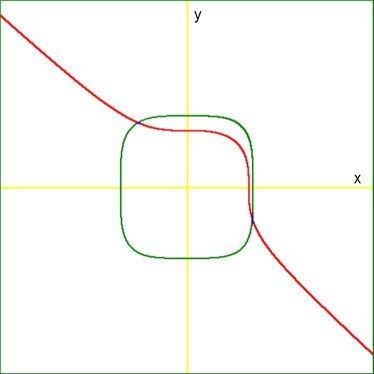

Viewport:
xmin := -4; xmax := +4; ymin := -4; ymax := +4;Color assignment: $$ \begin{cases} \color{red}{3x^3+4y^3=7}\\ \color{green}{4x^4+3y^4=16} \end{cases} $$ Hope this helps. (Now thinking about the rest ..)
EDIT. A parameter representation for the curve $\;3x^3+4y^3=7\;$ is: $$ x(t) = -\sqrt[3]{\frac{t}{3}} \qquad ; \qquad y(t) = \sqrt[3]{\frac{t+7}{4}} $$ This turns the problem into seeking zeroes of a one-dimensional function: $$ f(t) = 4 x^4(t) + 3 y^4(t) - 16 $$ Standard numerical methods can be employed for this purpose. Newton-Raphson and Regula Falsi have been successful here. Our (double precision) results are: $$ t = 3.56874527617414 \quad \Longrightarrow \quad (x,y) = ( -1.05957433921527 , +1.38246606572819 ) \\ t = -8.23503156460535 \quad \Longrightarrow \quad (x,y) = ( +1.40017183631184 , -0.675884813969605 ) $$ Giving, respectively: $$ x+y = 0.322891726512912 \\ x+y = 0.724287022342236 $$ ALGORITHM (Delphi Pascal) :
program RF;
type
funktie = function(t : double) : double;
function regula_falsi(d1,d0,eps : double; F : funktie) : double;
{
Regula Falsi
}
var
OK : boolean;
d2 : double;
begin
d2 := d0;
while abs(F(d2)) > eps do
begin
d2 := d1 - F(d1)*(d0 - d1)/(F(d0) - F(d1));
if F(d2) = 0 then Break;
OK := (F(d2)*F(d1) < 0);
if not OK then
begin
d1 := d2;
end else begin
d0 := d1; d1 := d2;
end;
Write(d2,' : ',F(d2),' ; Press Enter'); Readln;
end;
regula_falsi := d2;
end;
function power(x,r : double) : double;
var
M : double;
begin
M := 0;
if x > 0 then
M := exp(r*ln(abs(x)));
if x < 0 then
M := -exp(r*ln(abs(x)));
power := M;
end;
function original(t : double) : double;
{
Function itself
}
var
x,y,f : double;
begin
x := -power(t/3,1/3);
y := power((t+7)/4,1/3);
f := 4*sqr(sqr(x))+3*sqr(sqr(y))-16;
original := f
end;
procedure Calculate(x1,x2 : double);
const
eps : double = 1.E-14;
var
t,x,y,t1,t2 : double;
begin
t1 := 3*sqr(x1)*x1;
t2 := 3*sqr(x2)*x2;
t := Regula_Falsi(t1,t2,eps,original);
Writeln(t);
x := -power(t/3,1/3);
y := power(t/4+7/4,1/3);
Writeln(x,' +',y,' =',x+y);
end;
begin
Calculate( 1.0, 1.5);
Writeln;
Calculate(-1.5,-0.5);
end.
Note that the only place that is truly machine dependent is
the stopping criterion with 'eps'. As for the rest, the algorithm is
quite general. Also take note of the rather crude starting values $(1.0,1.5)$
and $(-1.5,-0.5)$ for $x$ at the end of the code, emphasizing the robustness of this algorithm.